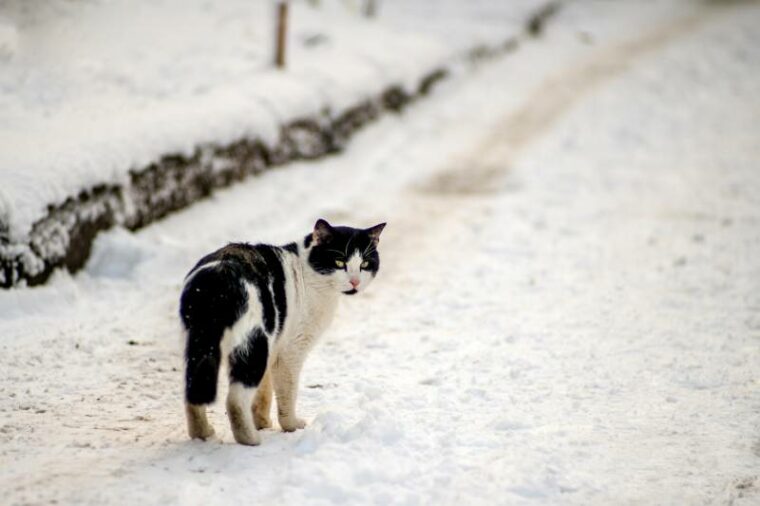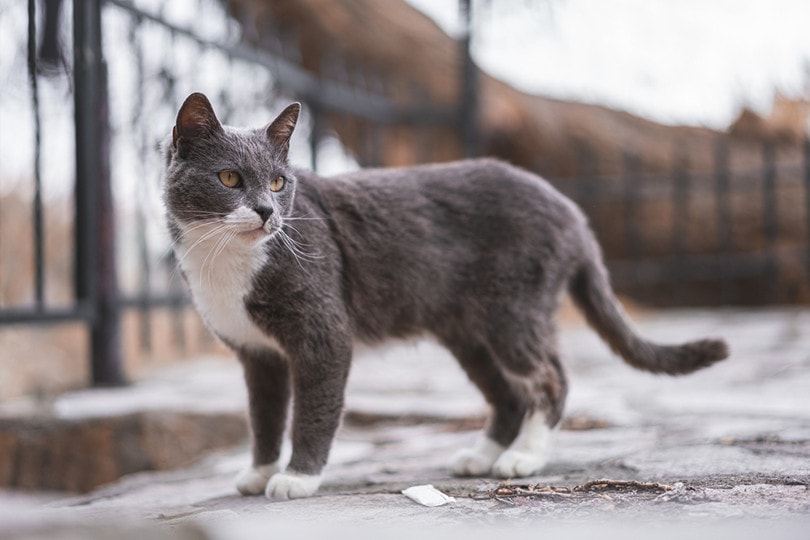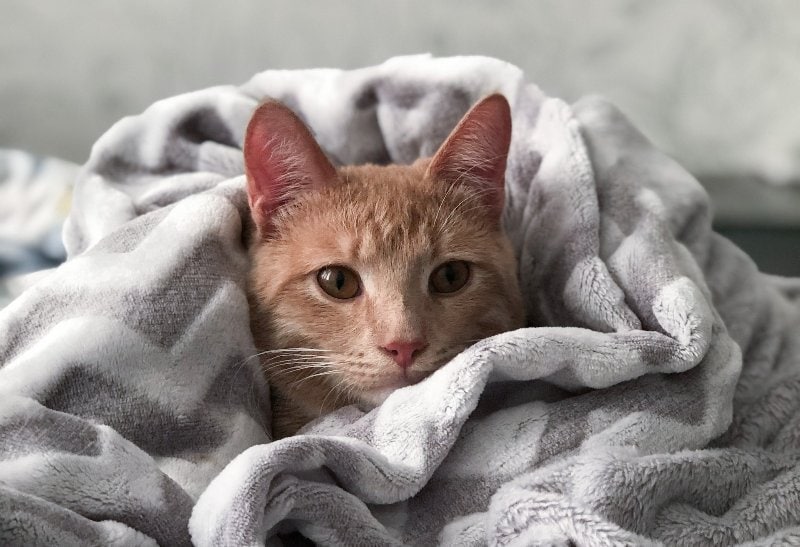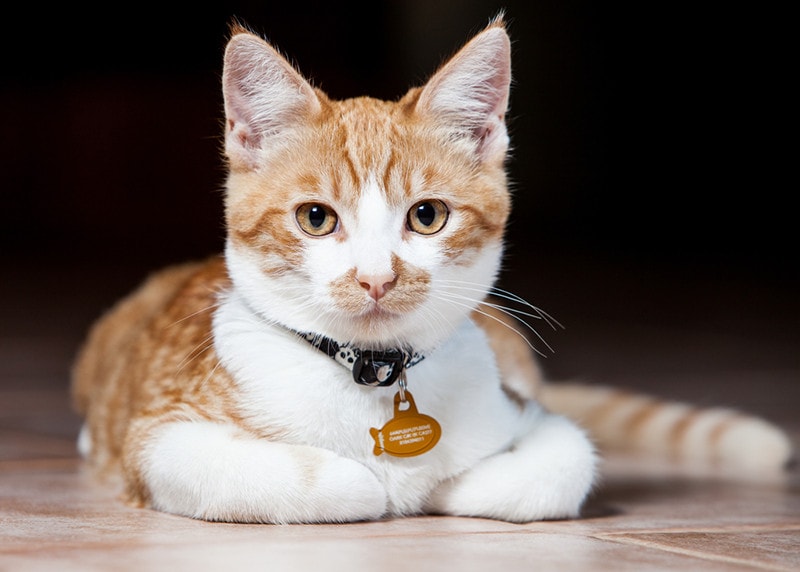- August 5, 2023
How Cold Is Too Cold for Your Cat to Go Outside? Our Vet Explains



The information is current and up-to-date in accordance with the latest veterinarian research.
Many people may think that because cats have a thick fur coat, like to hunt small prey, and have wild ancestors, they are fine to be outside in colder weather. And while there are numerous outdoor risks to consider, some might wonder, “How cold is too cold?” The truth is, there isn’t much in the way of current scientific studies to answer this specific question, but the American Veterinary Medical Association (AVMA) has recommended that “no pet should be left outside for long periods in below-freezing weather.” 1
In this article, we’ll explore more about cold weather and our feline friends as well as tips to keep your cat safe and mitigate risk regarding the cold weather.

Factors That Make a Difference
While commonly repeated veterinary advice may say that anything below “X” degrees or “colder than light jacket weather” is too cold for cats, the truth is that because each cat is an individual, even temperatures above freezing may pose a risk to some cats. The AVMA has recommended that cats should ideally be kept in the 50–80 degrees Fahrenheit (10–26.6 degrees Celsius) range with the humidity at 30%–70% 2. While this describes optimal conditions, one way to look at it is that the colder the temperature, the higher the risk to your cat. And while cats can be resourceful, even they have their own limits.
Factors that should all be taken into account to determine risk level can include:
- Age: Younger and older cats may be at an increased risk.
- Size: A small kitten may not have the body mass to last as long in the cold as compared to a larger one.
- Weight/body fat: Extra thin cats won’t be as likely to retain heat for as long as those that have some extra padding and insulation (keep in mind, overweight or obese cats are not considered “healthy” but in this case, they may have an advantage in cooler weather).
- Coat/breed specifics: Longer or thicker coats as well as breeds originating from colder regions may be more suited to colder weather.
- General health or disease status: Diabetes, cancer, thyroid problems, etc. may all affect how much change in the elements the cat can tolerate.
- Acclimated to cold: If you have a cat that has never been outside versus a cat that has lived outside in cold winters its whole life, the outdoor cat will be more accustomed to and knowledgeable about how to survive in severe weather.
- Amount of time outdoors: 5 minutes versus 5 hours versus 5 days? This can make a big difference!
- Precipitation: Rain or snow can cause it to be harder to keep warm. Imagine the difference between standing outside on a snowy day in a wet coat versus a dry coat.

Hypothermia In Cats
Hypothermia, where the body has a lower-than-normal body temperature, can occur in cats just like people! While normal temperatures for a cat can fluctuate, often the veterinary world will use around 99–102.5 degrees Fahrenheit as a rough guideline for a “normal” feline temperature. Mild, moderate, and severe hypothermia would be defined as follows:
- Mild hypothermia is in the 90–99 degrees F (32–37.2 degrees C) range and can include signs such as weakness, vigorous shivering, and confusion with varying but lowering heart and breathing rates.
- Moderate hypothermia is deemed to be 82–90 degrees F (28–32 degrees C) and can have signs such as difficulty walking, muscle stiffness, collapse, reduced shivering, and a progression of the above mild signs.
- Severe hypothermia is less than 82 degrees F (28 degrees C). This low of a number is typically approaching death and may include cold skin with fluid retention. The cat may be unable to shiver, their gums may be pale, they may experience muscle stiffness, and they often are facing the possibility of cardiac arrest. A coma with dilated and fixed pupils could also be possible.
A cat with hypothermia needs immediate treatment to return their body temperature to a normal range. To help them get to this point, veterinarians would provide nursing care such as external warming surfaces (blankets, heating pads, warm bath, forced warm air) while doing their best to warm appropriately so as not to cause further problems such as iatrogenic burns or cause cardiac problems. In addition, an appropriate diet, warmed intravenous (IV) fluids, warmed oxygen, and other more intensive warming options could also be implemented.
Frostbite in Cats
Frostbite is where the freezing of tissues on the body (eg: skin, ear tips, toes) occurs and can also happen in cats! Because freezing occurs more rapidly at colder temperatures, the colder the weather, the more likely frostbite is to occur. This can especially be true if the cat is not well acclimated or is in wet and windy cold conditions. For regions of the body that are not as well-insulated, such as the tips of the ears, the feet, or the tail, there is an increased risk of frostbite.
If frostbitten, these areas would appear pale, reddened, or swollen (or a combination), and the affected cat is thought to feel numb or painful in those areas. In more serious cases, the skin may die and slough off. Quickly and gently warming the affected area(s) and providing supportive care thereafter would be required for the healing process, but in severe cases, amputation may be needed.


Cold Weather Safety for Cats
So, if your cat is going to be or accidentally gets outside during cold weather, what are some things you can do to help them be more likely to stay safe?
1. Provide respite from the weather.
Simply keeping a cat indoors is the easiest way to do this but providing a cat-flap door may be an alternative as well if a cat is accustomed to going in and out. If keeping the cat indoors completely is not an option, providing an outdoor shelter with bedding that protects your cat from the elements is essential. These can be purchased or even constructed rather inexpensively and would be a great choice to help provide extra comfort, warmth, and dryness for a cat that is outside.

2. Access to food and water.
Cats may need more calories in colder weather and it’s also imperative that their water not be frozen. There are even heated water bowls you can buy for animals to be used outside!
3. Check under car hoods.
In cool or cold weather, car engines can be a warmer place for cats to curl up in, but this practice has notoriously resulted in severe injury and even death for many felines. Before starting a car, it’s recommended that you check under the car hood, bang on the hood a couple of times, and/or honk the horn to arouse a sleeping cat that may be staying warm on the engine before starting your car.

4. Common cold weather poisonings.
Antifreeze, which has a sweet taste, even in very small amounts can be very deadly to cats (and other animals). If suspected or actual ingestion has occurred, this is an emergency, and you should seek immediate veterinary care. Some preventative measures include using nontoxic propylene glycol instead of ethylene glycol products, keeping any containers closed and out of reach, and cleaning up any spills immediately and completely. Some other common winter items such as de-icers and rock salt ingestion also have the potential to make your cat sick, so be sure to store these products securely as well.
5. Identification options.
It is important to put a collar with the proper contact information on your cat, and having your cat microchipped is an additional layer of insurance. Use cat-safe collars, which stretch and/or contain a breakaway clasp, in the event the cat gets caught on something. Even if a collar is broken or torn off, if your cat is found and brought into a shelter or veterinary clinic, a microchip can immediately notify the finders of your contact information.


Conclusion
While there are no currently known studies that indicate exactly “how cold is too cold” when it comes to letting your cat outside, there are recommendations made by the American Veterinary Medical Association and others to help your cat be more likely to stay safe from colder weather. While each cat’s individual size, age, medical conditions, and prior experience will inform how well it can handle cold temperatures, keep in mind that the colder it is, the greater the health risks your cat will face.
Featured Image Credit: MaoriMurr, Shutterstock
Tags
What do you think?
Related Articles

New Puppy Checklist: Gear You’ll Need for Your New Dog
Getting a new puppy is really exciting, but before you welcome them home, it’s important to prepare your space for them. Since puppies need a

How Big Do Mini Poodles Get? Vet Reviewed Average Weight & Growth Chart – Dogster
The information is current and up-to-date in accordance with the latest veterinarian research. Learn more » When you buy a Miniature Poodle, you might not

Can Police Dogs Smell Nicotine? Vet Verified Facts & Info – Dogster
The information is current and up-to-date in accordance with the latest veterinarian research. Learn more » While cigarette sales have been declining steadily for decades,

How Old Is 5 in Dog Years? Vet-Approved Guide to Each Size of Dog – Dogster
The information is current and up-to-date in accordance with the latest veterinarian research. Learn more » A common method for calculating a dog’s age is

